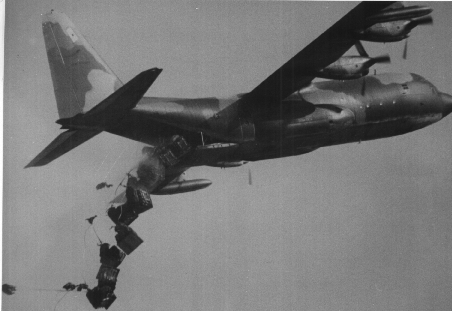

Airlift was one of the first
aspects of US military aid to the government of South Vietnam. Project FARM
GATE, the first American mission to South Vietnam, included C-47s in the special
operations role, a mission that included airlift and airdrop in addition to
other military tasks. FARM GATE was followed almost immediately by Project MULE
TRAIN, the deployment of a squadron of C-123s from Tactical Air Command's 464th
Troop Carrier Wing at Pope AFB, North Carolina, to Clark Air Base, Philippines.
After a very short stay at Clark, the first C-123s arrived at Tan Son Nhut in
early December, 1961, to begin the Vietnam Airlift. A few months later, over the
protest of the Air Force, the US Army sent a company of its CV-2 CARIBOU
transports to Vietnam. Though the CV-2 was severely limited as a transport, its
short-field landing capabilities allowed the tiny airplane to land where the
C-123 could not. The CARIBOU would prove useful in Vietnam in support of small,
isolated outposts where minimal payload requirements did not dictate the use of
larger airplanes.
While the C-47 was a very versatile airplane, its use
in the airlift role in Vietnam was very limited. Air transportation was a
mission of the FARM GATE special operations force; the C-47s were used quite
extensively in support of Special Forces outposts during the first year or two
of the war. But they were soon replaced by the C-123s and Army CV-2's in this
mission. The South Vietnamese Air Force air transport group was equipped with
C-47s, and its pilots were very skillful in the use of their airplanes. A need
for pilots in the VNAF strike squadrons led the United States to send two groups
of 30 USAF pilots to Vietnam to serve as copilots with Vietnamese crews. Known
as "The Dirty Thirty," the American pilots served with the VNAF squadrons in
1963 and 1964.
Although airlift support of the South Vietnamese military
was the primary object of the MULE TRAIN C-123s, the transports very quickly
became essential to the country's transportation infrastructure. About a dozen
existing airfields in the country served as links between Saigon and the rest of
South Vietnam. Combat operations originated from one of the 12 fields. Soon the
C-123s were operating scheduled flights between Saigon and Da Nang into certain
key airfields. But the C-123s had been sent to Vietnam for combat operations,
and the Americans felt this capability was not being exploited. Several airborne
operations were scheduled during the early years of the war, but the results
were poor, just as they were were with the heliborne operations that replaced
them. The Viet Cong were an elusive enemy who chose when and where they wanted
to fight, which meant only when they had the military advantage.
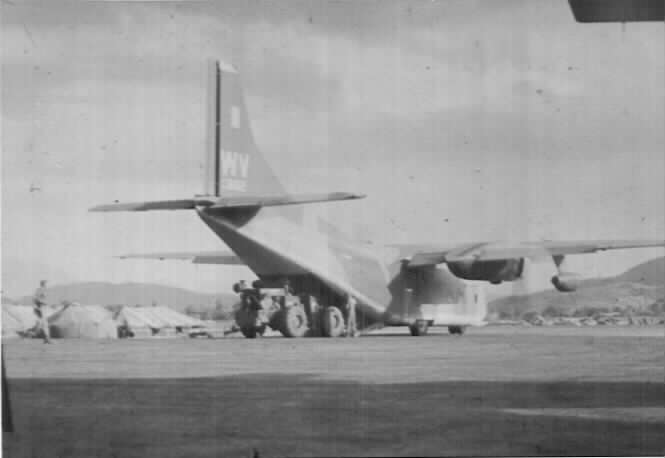

The
Vietnam War took a new turn in 1965 when President Johnson began his Rolling
Thunder bombing campaign against North Vietnam. Several fighter-bomber and
reconnaissance squadrons were dispatched to South Vietnam from Tactical Air
Command bases in the United States and from elsewhere in the Pacific. Along with
the air combat units, the 1st Marine Division and the Army's 173rd Airborne
Regiment arrived for duty in Vietnam. They were soon followed by other American
ground combat units.
Prior to 1965 the C-130s of the 315th Air Division
operated into Vietnam and Thailand from Okinawa, Japan and the Philippines. When
their superior capabilities were needed, C-130s were sent to Southeast Asia for
specific tasks. With the arrival of the American ground and air combat units,
airlift needs in the area increased and the first C-130s were sent to Saigon to
in-country airlift operations. Within six months those four airplanes had grown
to the equivelant of three squadrons, and would eventually grow to 90
airplanes.
In the fall of 1965 the 1st Cavalry's clash with North
Vietnamese forces in the I Drang Valley proved the usefulness of the C-130 in
combat operations. The Army had planned for the Cavalry to be an independent
unit and included an aviation company equipped with CV-2s as part of the
division. But the task of resupplying the unit's heliborne forces proved the
inadequacy of the CV-2 in the transport role. The airplane could carry only two
of the giant fuel bladders used to transport POL products in Vietnam. A C-130
could carry six times the load. A single C-130 could do the work of a whole
company of CV-2s, and the Army quickly realized that the Cavalry division was
going to be dependent upon the Air Force. The CV-2s were soon functioning more
or less like jeeps while the larger airlift tasks were exclusively an Air Force
responsibility, though the Marines operated a few of their own C-130s in I
Corps.
Throughout 1966 and 1967 the war in Vietnam was based on the
"search and destroy" concept, meaning American units operated into areas of
enemy infestation to search for his bases and then destroy them. Airlift was
crucial to the tactic. Air Force transports, usually C-130s, airlifted ground
personnel into airfields in close proximity to a planned operation then kept
them supplied during the ensuing operation. Helicopters supplied the troops in
the field, and moved units to and from their base camps. Shorter runways called
for the use of C-123s. In 1966 the Army's CV-2s were transferred to the Air
Force where they became the C-7. The CARIBOUS were used for small scale
operations into very short landing strips and for resupply of special forces
camps.
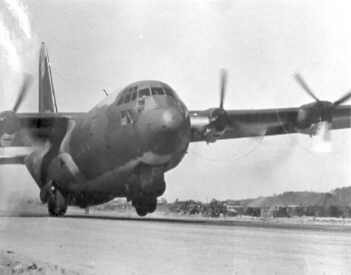
An attack on the cargo ramp at Dak To in November, 1967, signalled
that airlift had become a target for the enemy. Two C-130s were destroyed in the
attack, and a third was badly damaged as the Communists set out to make airlift
operations very costly for the Americans. In early 1968 a large Communist force
surrounded the Marine combat base at Khe Sanh in extreme northwestern South
Vietnam. For 77 days USAF and USMC transports and helicopters were the Marines
only link with the outside world. Artillery attacks on the base were fierce, and
were often keyed to the arrival of a transport. Marines at Khe Sanh began
referring to the C-130s as "mortar magnets," a name that soon became appropriate
throughout Vietnam. After the destruction of a Marine C-130 while landing at Khe
Sanh and the near-destruction of two USAF transports, Gen. William Momyer,
commander of Air Force operations in South Vietnam, curtailed C-130 landings at
the base. The airlift agency in South Vietnam, the 834th Air Division, turned to
C-130 airdrop as the primary means of resupply for the base defenders, with
C-123 landings an option when conditions and necessity permitted. The smaller
C-123s required less runway and could land and off-load then takeoff again
without leaving the runway. USMC C-130s also landed on occasion, along with a
few C-7s that brought in medical supplies too sensitive for airdrop.
Ground-controlled approach radar was used to position the transports over the
end of the runway, from which point the crew navigators found the drop zone
using onboard navigation equipment and timing.
Though containers were the
primary method of airdrop at Khe Sanh, the LAPES low-altitiude parachute method
allowed the delivery or larger items. But the confined drop zone made LAPES
somewhat dangerous. After a Marine was killed when a LAPES platform separated
from its parachute, the Air Force resurrected GPES, a low-altitude method using
a hook in the airplane to snare a cable on the ground to extract the
load.
After 77 days, the Marines at Khe Sanh were relieved. The
Communists had shifted south into the A Shau Valley and the 1st Cavalry Division
went into the valley after them. Operation DELAWARE called for C-130 airdrop to
supply the cavalrymen until the airfields at A Loui and Ta Bat could be
repaired. The A Shau drops were more dangerous than those at Khe Sanh. The drop
zone at a Loui lay 2,000 feet beneath mountain rides on either side of the
run-in. Clouds filled the valley down to 500 feet and sometimes less, while
visibilities were from 1-2 miles. Just getting into the valley required superior
airmenship and skill. To make matters worse, the Communists had positioned heavy
caliber antiaircraft and machineguns along the run-in route in anticipation of
the C-130 airdrops. Though fighters, F-4s from Da Nang, were scheduled to
provide fire suppression for the transports, the fighter pilots refused to fly
into the valley. The C-130 crews dropped anyway.
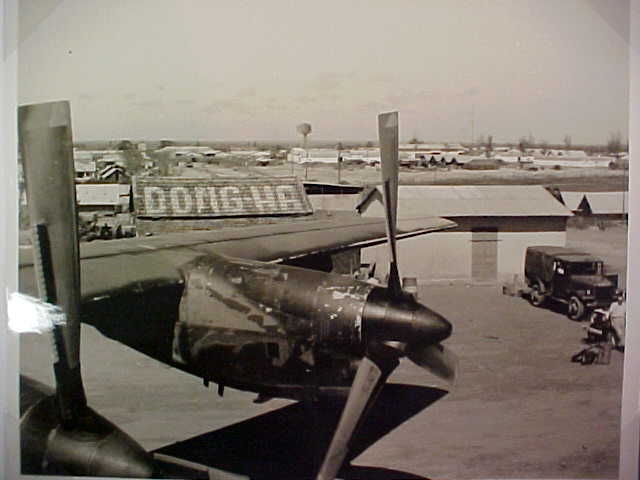
On the first day of
drops several C-130s were hit and suffered major battle damage. Shortly after
noon a C-130B from the 29th TAS was hit after the airplane broke out of the
clouds further down the valley than had previous drop planes. Smoke streamed
from the cargo compartment as the airplane came over the drop zone and the crew
attempted to jettison their load - to no avail. The pilot turned back toward the
airfield in an attempt to land, but the airplane struck a tree and slammed into
the ground to explode.
Three days later Capt Ross Kramer's crew had two
engines shot out during their approach to A Loui. They could see F-4s some
distance above them as they ran the gauntlet of Communist fire, but the fighter
pilots refused to come down and lend a hand to the transport they were supposed
to be escorting. Allegedly, 7th Air Force Commander Gen. William Momyer flew to
Da Nang to give the fighter pilots a personal chewing out. A fighter pilot
himself, Momyer had a special interest in TAC airlift and believed it to be an
important asset requiring special skill and an aggressive attittude. Momyer more
or less told the F-4 crews that if the transport crews could go into that hell,
so could they! After that, the fighters were there and no more transports were
lost or severely damaged.
On May 12, 1968 airlifters in Vietnam had their
finest hour as they were called upon to evacuate the camp at Kham Duc. Although
two C-130s were shot down and others were damaged, they manaqed to bring out
about half of the camps defenders while US Army and USMC helicopters brought out
the remaineder who did not exfiltrate out on the ground. After the camp had been
successfully evacuated, another C-130 was inexplicably ordered to land and
discharge members of an airlift control team who had been evacuated earlier in
the day. Two C-123s managed to land, but the first took off again without seeing
the stranded airmen until they had become airborne. The second C-123 landed and
picked them up. As the ranking man aboard the airplane, Lt. Col. Joe M. Jackson
was awarded the Medal of Honor. The instructor pilot, who had been
administeriing a check ride to Jackson, Major Jesse Campbell, was awarded the
Air Force Cross while the two enlisted crewmembers, Sergeants Truijo and Grubbs,
were given the Silver Star.
In the spring of 1972, after most American
ground forces had been withdrawn, the Communists launched a major offensive as
they invaded South Vietnam during Easter. Communist troops supported by tanks
and artillery rolled down Highway 13 toward Saigon, only to be halted after
passing the town of An Loc, which fell under siege. Airlift forces in Southeast
Asia had been withdrawn, with only the 374th Tactical Airlift Wing remaining of
what had been several wings of C-130s, C-123s and C-7s. Vietnamese C-123s
atttempted to supply the besieged garrison at An Loc, but were unsuccessful in
the face of the heaviest ground fire yet encountered in the Vietnam War.
Helicopter resupply was impossible due to the proliferation of automatic weapons
in the area. In desperation, the Military Assistance Command, Vietnam, ordered
the 374th to begin a resupply effort of the camp.
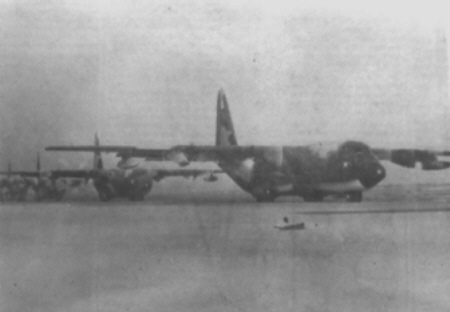

The missions to An Loc
were the most dangerous faced by airlifters in Vietnam, and perhaps in any war.
Communist gunners put up "a gauntlet of fire" when their outlying spotters
reported an approaching C-130. On the first day of drops Captain Bill Caldwell
and SSgt Charlie Shaub earned the Air Force Cross when they brought their
crippled airplane back to Tan Son Nhut after suffering major damage over An Loc.
Another C-130 was shot down the same day, and two more were to follow over the
next week. Night drops proved as dangerous as those flown in daytime, and as
unproductive. The siege was finally broken when the airlifters turned to
high-velocity drops from altitudes above the range of the antiaircraft at An
Loc, which included SA-7 shoulder-fired SAM missiles. A similar effort at Kontum
allowed the South Vietnamese defenders to hold that city as well.
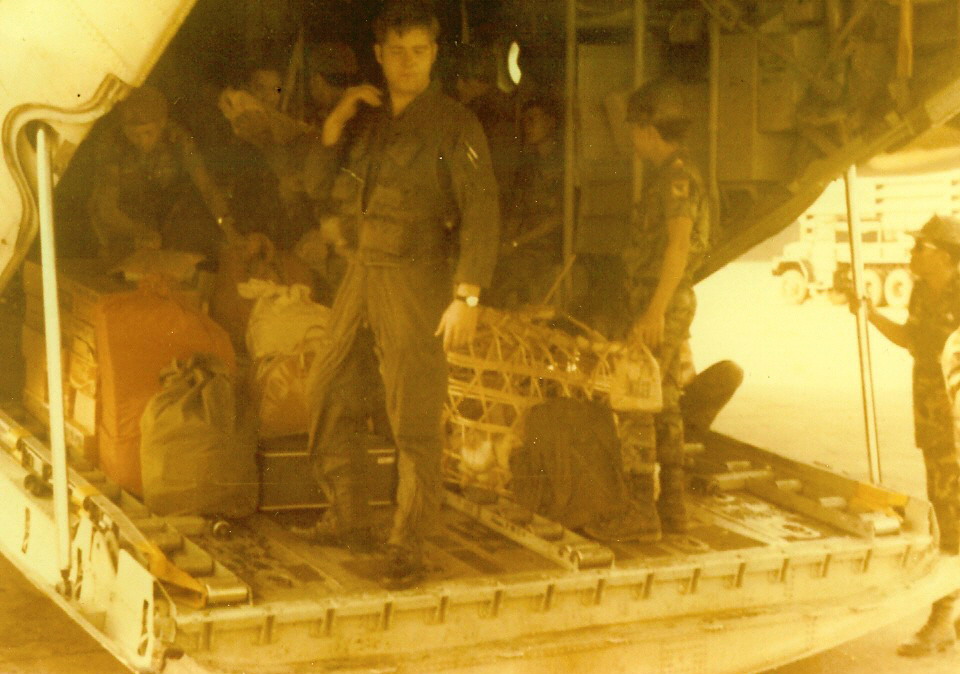
My friend Chris Gray. Chris was my roommate at Charleston.
In
February, 1973, the POWs, some of whom had been held since 1965, were finally
released. The Military Airlift Command was given the honor of bringing the POWS
home, but the MAC C-141 crews were upstaged by C-130 crewmen from the 374th TAW.
In preparation for the release, several C-130 flights transported members of the
negoitating team into Hanoi. On the day of the release two C-130 crews flew into
Gia Lam airport with members of the release team and an Air Force combat control
team who brought in homing devices to help the MAC crews find the airfield. When
the prisoners were released, the two C-130 crews were standing with nothing to
do. Seeing that the first prisoners were the most badly injured, SSgt Ron
Zogoda, a loadmaster, too the initiative as he stepped forward and took the arm
of the first prisoner to be released, then escorted him across more than 100
feet of tarmac to where the MAC "freedom birds" waited. (The MAC C-141 crews
were under strict instructions not to leave their airplanes.) The other members
of the two crews followed Zgoda's lead. When the POWS got to their first stop in
the Philippines, they told Gen. Wiliam Moore, commander of 13th Air Force, how
they appreciated the fact that the first Americans they talked too were combat
crewmembes like themselves. Consequently, on subsequent releases, the C-130
crews were assigned escort duty with the returning prisoners.
While
American combat participation in the Vietnam War ceased with the 1973 ceasefire,
airlift continued to play a role in the ongoing war in nearby Laos and Cambodia.
Throughout 1974 and into 1975 the United States maintained a major airlift of
supplies to the besieged Cambodian city of Phonm Penh. Fearful of the loss of an
Air Force crew, the United States turned to the use of civilian contract crews,
as they had done during the French IndoChina War. A company known as BirdAir
recruited former military airlifters to fly USAF C-130s provided "on loan" from
the Air Force for the resupply effort. In spite of the airlift effort, Phonm
Penh fell to the Communists in April, 1975, only a few days before Saigon also
fell, bringing the long Vietnam War to a final conclusion.
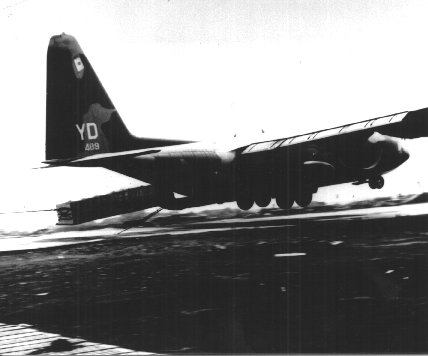
(A C-130A during a ground proximity extraction at Khe Sanh during the siege.)
Last Updated 9/23/2017